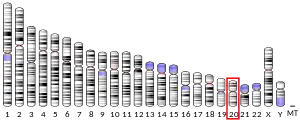Activity-dependent neuroprotector homeobox is a protein that in humans is encoded by the ADNP gene.[5]
Function
Vasoactive intestinal peptide is a neuroprotective factor that has a stimulatory effect on the growth of some tumor cells and an inhibitory effect on others. This gene encodes a protein that is upregulated by vasoactive intestinal peptide and may be involved in its stimulatory effect on certain tumor cells. The encoded protein contains one homeobox and nine zinc finger domains, suggesting that it functions as a transcription factor. This gene is also upregulated in normal proliferative tissues. Finally, the encoded protein may increase the viability of certain cell types through modulation of p53 activity. Alternatively spliced transcript variants encoding the same protein have been described.[5]
Clinical significance
Mutations in ADNP are the cause of ADNP syndrome.[6] Although it is unclear how mutations in the ADNP gene affect ADNP protein function, researchers suggest that the mutations result in abnormal chromatin remodeling. Disturbance of this process alters the activity of many genes and disrupts development or function of several of the body's tissues and organs, including the brain.[7]
References
- 1 2 3 GRCh38: Ensembl release 89: ENSG00000101126 - Ensembl, May 2017
- 1 2 3 GRCm38: Ensembl release 89: ENSMUSG00000051149 - Ensembl, May 2017
- ↑ "Human PubMed Reference:". National Center for Biotechnology Information, U.S. National Library of Medicine.
- ↑ "Mouse PubMed Reference:". National Center for Biotechnology Information, U.S. National Library of Medicine.
- 1 2 "Entrez Gene: Activity-dependent neuroprotector homeobox". Retrieved 2014-05-20.
- ↑ Helsmoortel C, Vulto-van Silfhout AT, Coe BP, Vandeweyer G, Rooms L, van den Ende J, Schuurs-Hoeijmakers JH, Marcelis CL, Willemsen MH, Vissers LE, Yntema HG, Bakshi M, Wilson M, Witherspoon KT, Malmgren H, Nordgren A, Annerén G, Fichera M, Bosco P, Romano C, de Vries BB, Kleefstra T, Kooy RF, Eichler EE, Van der Aa N (2014). "A SWI/SNF-related autism syndrome caused by de novo mutations in ADNP". Nature Genetics. 46 (4): 380–4. doi:10.1038/ng.2899. PMC 3990853. PMID 24531329.
- ↑ "ADNP syndrome: MedlinePlus Genetics". medlineplus.gov. Retrieved 2023-04-19.
External links
- Human ADNP genome location and ADNP gene details page in the UCSC Genome Browser.
Further reading
- Dresner E, Agam G, Gozes I (2011). "Activity-dependent neuroprotective protein (ADNP) expression level is correlated with the expression of the sister protein ADNP2: Deregulation in schizophrenia". European Neuropsychopharmacology. 21 (5): 355–61. doi:10.1016/j.euroneuro.2010.06.004. PMID 20598862. S2CID 28533690.
- Aboonq MS, Vasiliou SA, Haddley K, Quinn JP, Bubb VJ (2012). "Activity-dependent neuroprotective protein modulates its own gene expression". Journal of Molecular Neuroscience. 46 (1): 33–9. doi:10.1007/s12031-011-9562-y. PMID 21647709. S2CID 17185333.
- Kanková K, Stejskalová A, Pácal L, Tschoplová S, Hertlová M, Krusová D, Izakovicová-Hollá L, Beránek M, Vasků A, Barral S, Ott J (2007). "Genetic risk factors for diabetic nephropathy on chromosomes 6p and 7q identified by the set-association approach". Diabetologia. 50 (5): 990–9. doi:10.1007/s00125-007-0606-3. PMID 17345061.
- Zamostiano R, Pinhasov A, Gelber E, Steingart RA, Seroussi E, Giladi E, Bassan M, Wollman Y, Eyre HJ, Mulley JC, Brenneman DE, Gozes I (2001). "Cloning and characterization of the human activity-dependent neuroprotective protein". Journal of Biological Chemistry. 276 (1): 708–14. doi:10.1074/jbc.M007416200. PMID 11013255.
- Mandel S, Gozes I (2007). "Activity-dependent neuroprotective protein constitutes a novel element in the SWI/SNF chromatin remodeling complex". Journal of Biological Chemistry. 282 (47): 34448–56. doi:10.1074/jbc.M704756200. PMID 17878164.
- Nozawa RS, Nagao K, Masuda HT, Iwasaki O, Hirota T, Nozaki N, Kimura H, Obuse C (2010). "Human POGZ modulates dissociation of HP1α from mitotic chromosome arms through Aurora B activation". Nature Cell Biology. 12 (7): 719–727. doi:10.1038/ncb2075. PMID 20562864. S2CID 7389788.
- Yang MH, Yang YH, Lu CY, Jong SB, Chen LJ, Lin YF, Wu SJ, Chu PY, Chung TW, Tyan YC (2012). "Activity-dependent neuroprotector homeobox protein: A candidate protein identified in serum as diagnostic biomarker for Alzheimer's disease". Journal of Proteomics. 75 (12): 3617–29. doi:10.1016/j.jprot.2012.04.017. PMID 22554909.
- Braitch M, Kawabe K, Nyirenda M, Gilles LJ, Robins RA, Gran B, Murphy S, Showe L, Constantinescu CS (2010). "Expression of activity-dependent neuroprotective protein in the immune system: Possible functions and relevance to multiple sclerosis". Neuroimmunomodulation. 17 (2): 120–5. doi:10.1159/000258695. PMC 3701887. PMID 19923857.
- Rosnoblet C, Vandamme J, Völkel P, Angrand PO (2011). "Analysis of the human HP1 interactome reveals novel binding partners". Biochemical and Biophysical Research Communications. 413 (2): 206–11. doi:10.1016/j.bbrc.2011.08.059. PMID 21888893.
This article incorporates text from the United States National Library of Medicine, which is in the public domain.



